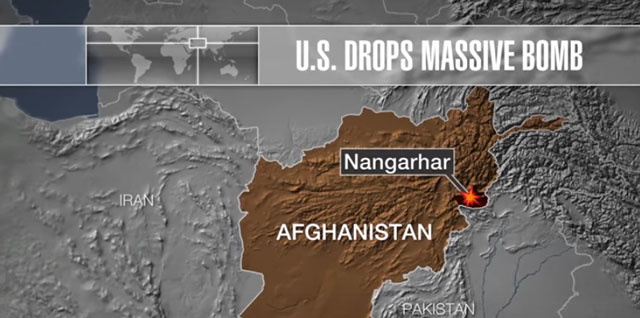
Jalalabad, Afghanistan | AFP | Security forceswere still blocking accessWednesday to the site in eastern Afghanistan where the US dropped a massive bomb on an Islamic State group stronghold six days ago.
The US military dropped its GBU-43/B Massive Ordnance Air Blast, dubbed the “Mother of All Bombs”, in combat for the first time on April 13.
The target was caves and hideouts being used by the jihadist group in the Achin district of Nangargar province.
The blast triggered shockwaves which residents said they felt miles away. It was said by the Afghan defence ministry to have killed at least 95 militants, including some IS commanders and foreign fighters, but no civilians.
The statement could not be independently verified, with reporters including AFP correspondents turned away from the site again Wednesday even though there was no sign of fighting in the immediate area.
Ahmad Jan, a resident of Achin who fled IS fighting and moved with his family to the provincial capital Jalalabad long before the bomb was dropped, told AFP he had no idea whether his house or relatives survived the attack.
“No one can go there, they have completely blocked the area. I don’t know if my house is destroyed. They have not even shown any dead bodies to anyone,” he said.
A spokesman for Afghan special forces said landmines and “pockets of resistance” on top of mountains had slowed down operations in the area. He did not specify if the fighters were Islamic State.
Police officials in Nangarhar could not immediately comment, and US-led NATO forces in Afghanistan would not comment Wednesday. They said this week they were still assessing the situation.
Some Afghans have condemned the use of their country as what they called a testing ground for the weapon, and against a militant group that is not considered as big a threat as the resurgent Taliban.
Analyst and retired general Atiqullah Amarkhail told AFP the US military needed time to analyse the impact and clean the debris.
“It was not an ordinary bomb. It carried a special kind of explosives, it was tested in a mountainous area for the first time, I believe a team of US experts are now working on the ground to assess the effects and impacts,” he said.
IS, notorious for its reign of terror in Syria and Iraq, has made inroads into Afghanistan in recent years, attracting disaffected members of the Pakistani and Afghan Taliban as well as Uzbek Islamists.
But the group has been steadily losing ground in the face of heavy pressure both from US air strikes and a ground offensive led by Afghan forces.
 The Independent Uganda: You get the Truth we Pay the Price
The Independent Uganda: You get the Truth we Pay the Price



